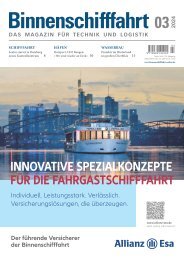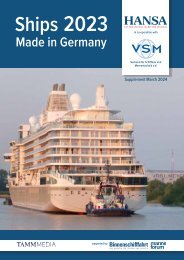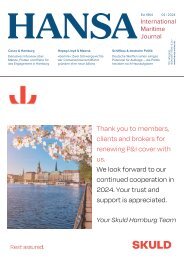HANSA 01-2017
HSH Nordbank | Wasserbau | Biokraftstoffe | Biomemetik | Fokus Shortsea | Emissionen & MRV | Börsen & Aktien | Südamerika-Verkehr | Maritime Silk Road | Linnhoff | Sprachtests
HSH Nordbank | Wasserbau | Biokraftstoffe | Biomemetik | Fokus Shortsea | Emissionen & MRV | Börsen & Aktien | Südamerika-Verkehr | Maritime Silk Road | Linnhoff | Sprachtests
Sie wollen auch ein ePaper? Erhöhen Sie die Reichweite Ihrer Titel.
YUMPU macht aus Druck-PDFs automatisch weboptimierte ePaper, die Google liebt.
Schifffahrt | Shipping<br />
Costs, not SECAs make RoRo steam slow<br />
The issue of speed is more complex for RoRo/RoPax vessels than other segments.<br />
A Swedish research team has addressed the preconditions for introducing slow steaming<br />
in Northern Europe and asked operators in Scandinavian waters how they prepared<br />
and have acted under SECA<br />
In the northern European market, RoRo<br />
and RoPax shipping services often face<br />
direct competition with road and rail options<br />
that are generally less safe and more<br />
congested and potentially more damaging<br />
to the environment. The environmental<br />
performance of RoRo shipping is, however,<br />
critically dependent on sailing speed,<br />
energy effciency and capacity utilisation.<br />
In 2<strong>01</strong>4 the combination of a slow RoRo<br />
market, high bunker costs, the upcoming<br />
SECA regulations and customers increasingly<br />
sensitive to transport’s environmental<br />
footprint triggered discussions on how<br />
the shipping industry could cope with the<br />
changed conditions.<br />
Varying the speed is normal procedure<br />
in several shipping segments, mainly used<br />
for tying up capacity to raise freight rates<br />
but also for lowering bunker costs and environmental<br />
footprint. This is not very<br />
complicated for tank and dry bulk ships<br />
transporting low-value cargo for a single or<br />
a few shippers. The transport cost is high<br />
compared to the value of the goods and<br />
fuel costs constitute a major cost for the<br />
shipowners. Hence the shipowner and the<br />
shipper share an interest in low speed and<br />
can negotiate directly. AIS data for 2<strong>01</strong>3–<br />
2<strong>01</strong>5 reveal typical speeds of 13–14 knots<br />
in the waters around Sweden.<br />
Also trans-ocean container shipping applies<br />
slow steaming. In a previous project,<br />
the research team asked Swedish shippers<br />
how they are affected by slow steaming and<br />
a workshop revealed their coping strategies.<br />
As a large container vessel mixes a wide variety<br />
of cargo with different time requirements,<br />
the shipping lines cannot negotiate<br />
with all shippers, but one of the world’s<br />
largest container shippers witnessed that<br />
even they were informed about changed<br />
timetables without previous dialogue.<br />
Slow steaming is particularly troublesome<br />
for one of the interviewed shippers, which<br />
started to manufacture in Sweden, continued<br />
in China and finalised its products in<br />
Sweden. When selling them in China they<br />
suffered from four slow steaming legs and<br />
they had to shift to air freight.<br />
The issue of speed is even more complex<br />
for the RoPax vessels than other segments.<br />
Bunker costs are less significant compared<br />
to time-dependent costs due to expensive<br />
vessels and large crews. The variety in demand<br />
is also as wide as it gets in the transport<br />
industry. Travellers with cars who want<br />
to cross the water to continue driving are<br />
mixed with passengers who want to eat,<br />
shop or just entertain themselves on board.<br />
Time-critical cargoes like vegetables, components<br />
scheduled for assembly, and e-commerce<br />
deliveries are loaded on lorries driven<br />
on board by drivers and mixed with less demanding<br />
goods loaded in unaccompanied<br />
semi-trailers or containers. Revenues obviously<br />
stem from the transport service, but<br />
there is also a time-dependent element in<br />
terms of sales on board.<br />
Hence, scheduling is a big compromise<br />
between different time requirements and<br />
the compromise differs between routes,<br />
time of the day and season. Most customers<br />
want a high speed, but on some routes<br />
a slow speed is a value added for passengers<br />
who want to eat and lorry and bus drivers<br />
who want to use the crossing as resting<br />
time. To further complicate the issue,<br />
a lower speed might force the shipping line<br />
to deploy more or larger ships, choose a<br />
shorter crossing or skew the timetable between<br />
days. Competition with land modes<br />
and fixed connection is also likely to be affected.<br />
If the speed is significantly changed,<br />
the vessel might have to be reconfigured<br />
to get the right combination of shops, restaurants,<br />
bars, seating areas and cabins.<br />
In addition, operating far from the design<br />
speed is likely to necessitate rebuilding of<br />
the hull, change of propellers and possibly<br />
also adjustments to the engines.<br />
Significant inertia<br />
There is thus significant inertia to slow<br />
steaming in the RoRo/RoPax segment.<br />
According to AIS data, speeds between<br />
20 and 23 knots are common on open waters<br />
in the Baltic and North Seas, and some<br />
routes involve high-speed ferries like Destination<br />
Gotland’s, which are built for up<br />
to 32 knots. Some years ago, however, SOL<br />
marketed its discontinued 14 knots RoRo<br />
service between Helsingborg and Travemünde<br />
as the »Slowest service in the<br />
South Baltic Sea«. The present study indicated<br />
that slow steaming is rare in the short<br />
sea RoRo/RoPax segment. It was also evident<br />
that, like the shipowners, researchers<br />
have paid less attention to slow steaming in<br />
the RoRo/RoPax segment than other shipping<br />
segments. One reason for the research<br />
community’s reluctance is the contextual<br />
character of RoRo/RoPax with conditions<br />
shifting between geographical markets,<br />
routes and seasons making it hard to generalise<br />
results.<br />
The research project was staged in<br />
2<strong>01</strong>3 when high bunker costs made alarmists<br />
claim that SECA would force the manufacturing<br />
industry to leave the shores of<br />
the Baltic Sea and that RoRo/RoPax shipping<br />
would be replaced by land modes.<br />
Some studies agreed with the alarmists<br />
while other analyses for the European<br />
Commission did not project any major<br />
modal backshift. Together with scrubbers<br />
and alternative fuels, slow steaming was<br />
put forward as a SECA mitigation strategy.<br />
Anyway, the sharp decline in the oil<br />
price by the end of 2<strong>01</strong>4 made many of the<br />
studies obsolete and the shipping lines opting<br />
for just buying MGO looked like winners<br />
in the short run. In addition, it made<br />
the consequence analyses of SECA, including<br />
this one, diffcult as the price of MGO<br />
dropped even below the price of HFO in<br />
mid-2<strong>01</strong>4 and the price gap has decreased.<br />
Nonetheless, for the interviews,<br />
25 RoRo/RoPax companies operating in<br />
the North and Baltic Seas were approached<br />
and in the end, 11 managers participated<br />
in semi-structured personal or telephone<br />
interviews. The interviews focused on<br />
the companies’ SECA compliance strategies,<br />
customer requirements, and current<br />
practice and future plans regarding slow<br />
steaming.<br />
The research reveals that schedule flexibility,<br />
transit time and service reliability<br />
are crucial for the customers and the demand<br />
is highly price elastic. Vessel characteristics,<br />
operating route, and the price gap<br />
between MGO and HFO are some key parameters<br />
for the selection of an appropriate<br />
SECA compliance strategy. In the short<br />
42 <strong>HANSA</strong> International Maritime Journal – 154. Jahrgang – 2<strong>01</strong>7 – Nr. 1


















